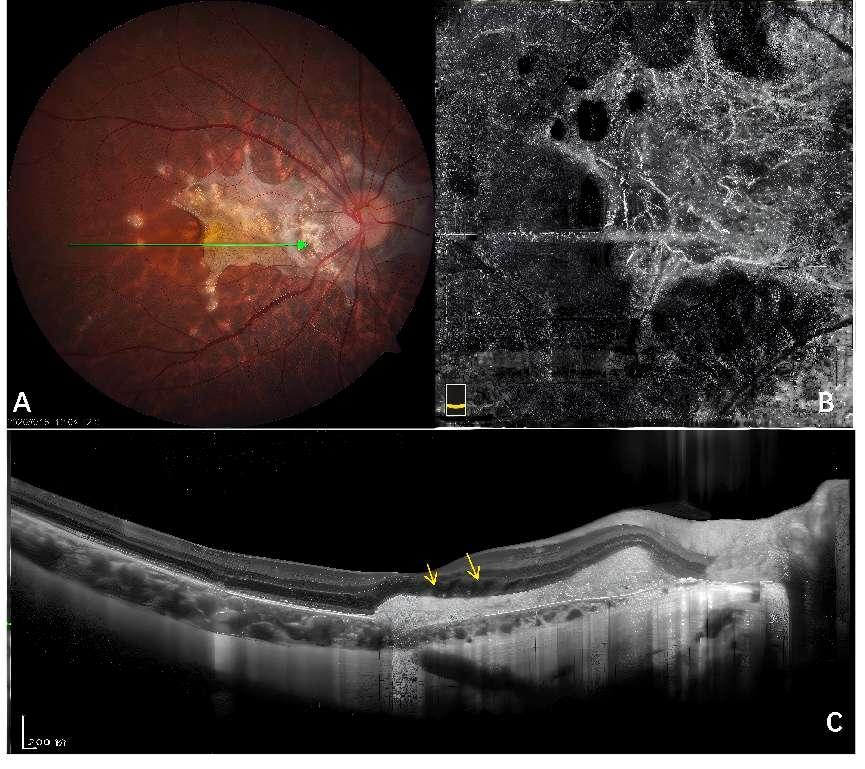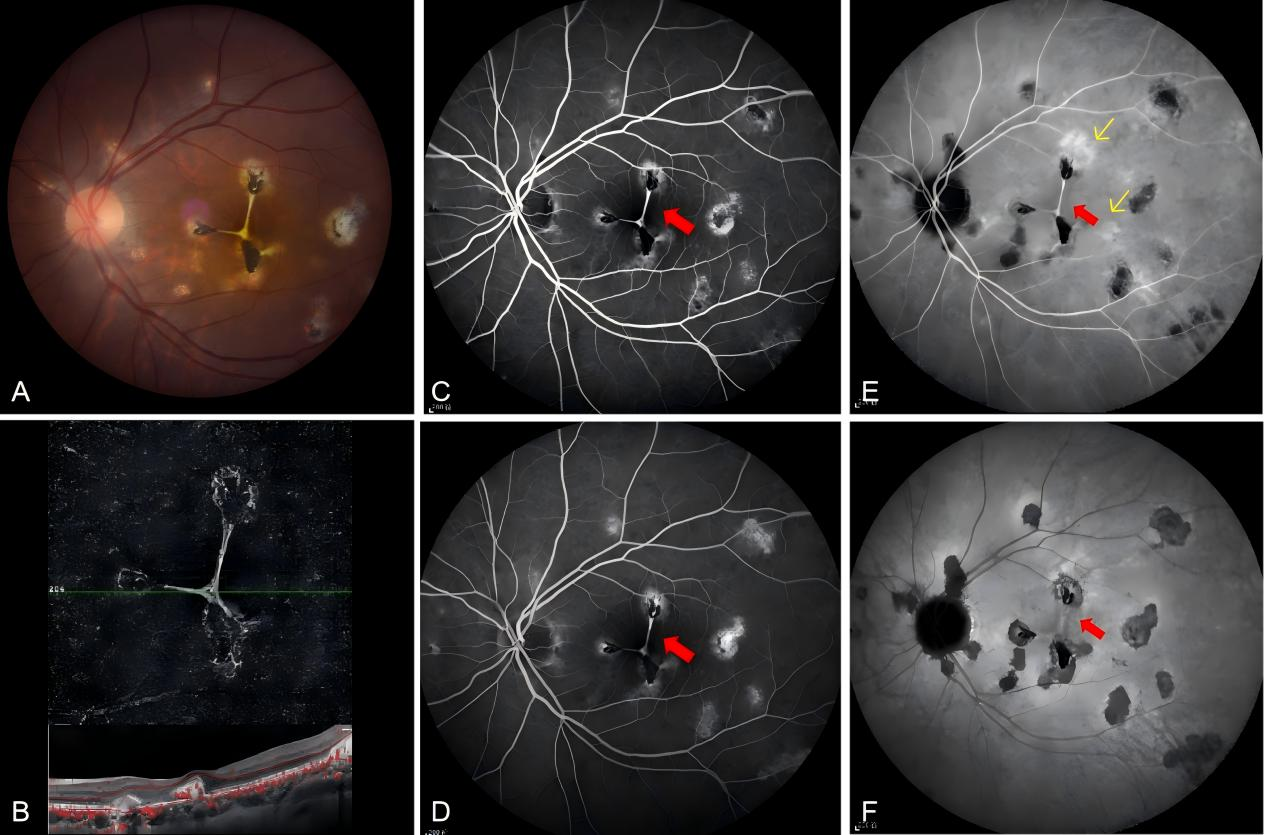1、Agarwal A, Invernizzi A, Singh RB, et al. An update on inflammatory
choroidal neovascularization: epidemiology, multimodal imaging,
and management. J Ophthalmic Inflamm Infect, 2018, 8(1): 13. DOI: 10.1186/s12348-018-0155-6.Agarwal A, Invernizzi A, Singh RB, et al. An update on inflammatory
choroidal neovascularization: epidemiology, multimodal imaging,
and management. J Ophthalmic Inflamm Infect, 2018, 8(1): 13. DOI: 10.1186/s12348-018-0155-6.
2、Invernizzi A, Pichi F, Symes R, et al. Twenty-four-month outcomes of
inflammatory choroidal neovascularisation treated with intravitreal
anti-vascular endothelial growth factors: a comparison between two
treatment regimens. Br J Ophthalmol, 2020, 104(8): 1052-1056. DOI:
10.1136/bjophthalmol-2019-315257.Invernizzi A, Pichi F, Symes R, et al. Twenty-four-month outcomes of
inflammatory choroidal neovascularisation treated with intravitreal
anti-vascular endothelial growth factors: a comparison between two
treatment regimens. Br J Ophthalmol, 2020, 104(8): 1052-1056. DOI:
10.1136/bjophthalmol-2019-315257.
3、Giuffrè C, Marchese A, Fogliato G, et al. The “sponge sign”: a novel
feature of inflammatory choroidal neovascularization. Eur J Ophthalmol,
2021, 31(3): 1240-1247. DOI: 10.1177/1120672120917621.Giuffrè C, Marchese A, Fogliato G, et al. The “sponge sign”: a novel
feature of inflammatory choroidal neovascularization. Eur J Ophthalmol,
2021, 31(3): 1240-1247. DOI: 10.1177/1120672120917621.
4、Karska-Basta%20I%2C%20Pociej-Marciak%20W%2C%20%C5%BBuber-%C5%81askawiec%20K%2C%20et%20al.%20Diagnostic%20%0Achallenges%20in%20inflammatory%20choroidal%20neovascularization.%20Medicina%20%0A(Kaunas)%2C%202024%2C%2060(3)%3A%20465.%20DOI%3A%2010.3390%2Fmedicina60030465.Karska-Basta%20I%2C%20Pociej-Marciak%20W%2C%20%C5%BBuber-%C5%81askawiec%20K%2C%20et%20al.%20Diagnostic%20%0Achallenges%20in%20inflammatory%20choroidal%20neovascularization.%20Medicina%20%0A(Kaunas)%2C%202024%2C%2060(3)%3A%20465.%20DOI%3A%2010.3390%2Fmedicina60030465.
5、Woronkowicz M, Niederer R, Lightman S, et al. Intravitreal antivascular
endothelial growth factor treatment for inflammatory choroidal
neovascularization in noninfectious uveitis. Am J Ophthalmol, 2022,
236: 281-287. DOI: 10.1016/j.ajo.2021.07.010.Woronkowicz M, Niederer R, Lightman S, et al. Intravitreal antivascular
endothelial growth factor treatment for inflammatory choroidal
neovascularization in noninfectious uveitis. Am J Ophthalmol, 2022,
236: 281-287. DOI: 10.1016/j.ajo.2021.07.010.
6、Baxter SL , Pistilli M , Pujari SS, et al . Risk of choroidal
neovascularization among the uveitides. Am J Ophthalmol, 2013,
156(3): 468-477.e2. DOI: 10.1016/j.ajo.2013.04.040.Baxter SL , Pistilli M , Pujari SS, et al . Risk of choroidal
neovascularization among the uveitides. Am J Ophthalmol, 2013,
156(3): 468-477.e2. DOI: 10.1016/j.ajo.2013.04.040.
7、Moorthy RS, Chong LP, Smith RE, et al. Subretinal neovascular
membranes in vogt-koyanagi-harada syndrome. Am J Ophthalmol,
1993, 116(2): 164-170. DOI: 10.1016/s0002-9394(14)71280-2.Moorthy RS, Chong LP, Smith RE, et al. Subretinal neovascular
membranes in vogt-koyanagi-harada syndrome. Am J Ophthalmol,
1993, 116(2): 164-170. DOI: 10.1016/s0002-9394(14)71280-2.
8、Zhang X, Wen F, Zuo C, et al. Clinical features of punctate inner
choroidopathy in Chinese patients. Retina, 2011, 31(8): 1680-1691.
DOI: 10.1097/IAE.0b013e31820a67ad.Zhang X, Wen F, Zuo C, et al. Clinical features of punctate inner
choroidopathy in Chinese patients. Retina, 2011, 31(8): 1680-1691.
DOI: 10.1097/IAE.0b013e31820a67ad.
9、Wu K, Zhang X, Su Y, et al. Clinical characteristics of inflammatory choroidal
neovascularization in a Chinese population. Ocul Immunol Inflamm, 2016,
24(3): 261-267. DOI: 10.3109/09273948.2015.1015741.Wu K, Zhang X, Su Y, et al. Clinical characteristics of inflammatory choroidal
neovascularization in a Chinese population. Ocul Immunol Inflamm, 2016,
24(3): 261-267. DOI: 10.3109/09273948.2015.1015741.
10、Miyata M, Ooto S, Hata M, et al. Detection of myopic choroidal
neovascularization using optical coherence tomography angiography. Am J
Ophthalmol, 2016, 165: 108-114. DOI: 10.1016/j.ajo.2016.03.009.Miyata M, Ooto S, Hata M, et al. Detection of myopic choroidal
neovascularization using optical coherence tomography angiography. Am J
Ophthalmol, 2016, 165: 108-114. DOI: 10.1016/j.ajo.2016.03.009.
11、Gan Y, Zhang X, Su Y, et al. OCTA versus dye angiography for the
diagnosis and evaluation of neovascularisation in punctate inner
choroidopathy. Br J Ophthalmol, 2022, 106(4): 547-552. DOI:
10.1136/bjophthalmol-2020-318191.Gan Y, Zhang X, Su Y, et al. OCTA versus dye angiography for the
diagnosis and evaluation of neovascularisation in punctate inner
choroidopathy. Br J Ophthalmol, 2022, 106(4): 547-552. DOI:
10.1136/bjophthalmol-2020-318191.
12、Jabs DA, McCluskey P, Palestine AG, et al. The standardisation of
uveitis nomenclature (SUN) project. Clinical Exper Ophthalmology,
2022, 50(9): 991-1000. DOI: 10.1111/ceo.14175.Jabs DA, McCluskey P, Palestine AG, et al. The standardisation of
uveitis nomenclature (SUN) project. Clinical Exper Ophthalmology,
2022, 50(9): 991-1000. DOI: 10.1111/ceo.14175.
13、Coscas GJ, Lupidi M, Coscas F, et al. Optical coherence tomography
angiography versus traditional multimodal imaging in assessing
the activity of exudative age-related macular degeneration: a New
Diagnostic Challenge. Retina, 2015, 35(11): 2219-2228. DOI:
10.1097/IAE.0000000000000766.Coscas GJ, Lupidi M, Coscas F, et al. Optical coherence tomography
angiography versus traditional multimodal imaging in assessing
the activity of exudative age-related macular degeneration: a New
Diagnostic Challenge. Retina, 2015, 35(11): 2219-2228. DOI:
10.1097/IAE.0000000000000766.
14、Zhang Y, Gan Y, Zeng Y, et al. Incidence and multimodal imaging
characteristics of macular neovascularisation subtypes in Chinese
neovascular age-related macular degeneration patients. Br J
Ophthalmol, 2024, 108(3): 391-397. DOI: 10.1136/bjo-2022-322392.Zhang Y, Gan Y, Zeng Y, et al. Incidence and multimodal imaging
characteristics of macular neovascularisation subtypes in Chinese
neovascular age-related macular degeneration patients. Br J
Ophthalmol, 2024, 108(3): 391-397. DOI: 10.1136/bjo-2022-322392.
15、Liu Y, Wen F, Huang S, et al. Subtype lesions of neovascular age-related
macular degeneration in Chinese patients. Graefes Arch Clin Exp
Ophthalmol, 2007, 245(10): 1441-1445. DOI: 10.1007/s00417-007-
0575-8.Liu Y, Wen F, Huang S, et al. Subtype lesions of neovascular age-related
macular degeneration in Chinese patients. Graefes Arch Clin Exp
Ophthalmol, 2007, 245(10): 1441-1445. DOI: 10.1007/s00417-007-
0575-8.
16、Spaide RF, Jaffe GJ, Sarraf D, et al. Consensus nomenclature for
reporting neovascular age-related macular degeneration data: consensus
on neovascular age-related macular degeneration nomenclature study
group. Ophthalmology, 2020, 127(5): 616-636. DOI: 10.1016/
j.ophtha.2019.11.004.Spaide RF, Jaffe GJ, Sarraf D, et al. Consensus nomenclature for
reporting neovascular age-related macular degeneration data: consensus
on neovascular age-related macular degeneration nomenclature study
group. Ophthalmology, 2020, 127(5): 616-636. DOI: 10.1016/
j.ophtha.2019.11.004.
17、Gan Y, Ji Y, Zuo C, et al. Correlation between focal choroidal excavation
and underlying retinochoroidal disease: a Pathological Hypothesis
From Clinical Observation. Retina, 2022, 42(2): 348-356. DOI:
10.1097/IAE.0000000000003307.Gan Y, Ji Y, Zuo C, et al. Correlation between focal choroidal excavation
and underlying retinochoroidal disease: a Pathological Hypothesis
From Clinical Observation. Retina, 2022, 42(2): 348-356. DOI:
10.1097/IAE.0000000000003307.
18、Jampol LM, Shankle J, Schroeder R, et al. Diagnostic and therapeutic
challenges. Retina, 2006, 26(9): 1072-1076. DOI: 10.1097/01.
iae.0000248819.86737.a5.Jampol LM, Shankle J, Schroeder R, et al. Diagnostic and therapeutic
challenges. Retina, 2006, 26(9): 1072-1076. DOI: 10.1097/01.
iae.0000248819.86737.a5.
19、Xu H, Zeng F, Shi D, et al. Focal choroidal excavation complicated by choroidal neovascularization. Ophthalmology, 2014, 121(1): 246-250.
DOI: 10.1016/j.ophtha.2013.08.014.Xu H, Zeng F, Shi D, et al. Focal choroidal excavation complicated by choroidal neovascularization. Ophthalmology, 2014, 121(1): 246-250.
DOI: 10.1016/j.ophtha.2013.08.014.
20、Obata R, Takahashi H, Ueta T, et al. Tomographic and angiographic
characteristics of eyes with macular focal choroidal excavation. Retina,
2013, 33(6): 1201-1210. DOI: 10.1097/IAE.0b013e31827b6452.Obata R, Takahashi H, Ueta T, et al. Tomographic and angiographic
characteristics of eyes with macular focal choroidal excavation. Retina,
2013, 33(6): 1201-1210. DOI: 10.1097/IAE.0b013e31827b6452.
21、de Groot EL, Ten Dam-van Loon, N H, Kouwenberg CV, et al.
Exploring imaging characteristics associated with disease activity in
idiopathic multifocal choroiditis: a multimodal imaging approach. Am J
Ophthalmol, 2023, 252: 45-58. DOI: 10.1016/j.ajo.2023.03.022.de Groot EL, Ten Dam-van Loon, N H, Kouwenberg CV, et al.
Exploring imaging characteristics associated with disease activity in
idiopathic multifocal choroiditis: a multimodal imaging approach. Am J
Ophthalmol, 2023, 252: 45-58. DOI: 10.1016/j.ajo.2023.03.022.
22、Zhang X, Zuo C, Li M, et al. Spectral-domain optical coherence
tomographic findings at each stage of punctate inner choroidopathy.
Ophthalmology, 2013, 120(12): 2678-2683. DOI: 10.1016/
j.ophtha.2013.05.012.Zhang X, Zuo C, Li M, et al. Spectral-domain optical coherence
tomographic findings at each stage of punctate inner choroidopathy.
Ophthalmology, 2013, 120(12): 2678-2683. DOI: 10.1016/
j.ophtha.2013.05.012.
23、Olsen TW, Capone A Jr, Sternberg P Jr, et al. Subfoveal choroidal
neovascularization in punctate inner choroidopathy. Surgical
management and pathologic findings. Ophthalmology, 1996, 103(12):
2061-2069. DOI: 10.1016/s0161-6420(96)30387-4.Olsen TW, Capone A Jr, Sternberg P Jr, et al. Subfoveal choroidal
neovascularization in punctate inner choroidopathy. Surgical
management and pathologic findings. Ophthalmology, 1996, 103(12):
2061-2069. DOI: 10.1016/s0161-6420(96)30387-4.
24、Liu B, Zhang X, Peng Y, et al. Etiologies and characteristics of choroidal
neovascularization in young Chinese patients. Ophthalmologica, 2019,
241(2): 73-80. DOI: 10.1159/000492133.Liu B, Zhang X, Peng Y, et al. Etiologies and characteristics of choroidal
neovascularization in young Chinese patients. Ophthalmologica, 2019,
241(2): 73-80. DOI: 10.1159/000492133.
25、Wang JC, McKay KM, Sood AB, et al. Comparison of choroidal
neovascularization secondary to white dot syndromes and age�related macular degeneration by using optical coherence tomography
angiography. Clin Ophthalmol, 2018, 13: 95-105. DOI: 10.2147/
OPTH.S185468.Wang JC, McKay KM, Sood AB, et al. Comparison of choroidal
neovascularization secondary to white dot syndromes and age�related macular degeneration by using optical coherence tomography
angiography. Clin Ophthalmol, 2018, 13: 95-105. DOI: 10.2147/
OPTH.S185468.
26、Miere A, Butori P, Cohen SY, et al. Vascular remodeling of choroidal
neovascularization after anti-vascular endothelial growth factor therapy
visualized on optical coherence tomography angiography. Retina, 2019,
39(3): 548-557. DOI: 10.1097/IAE.0000000000001964.Miere A, Butori P, Cohen SY, et al. Vascular remodeling of choroidal
neovascularization after anti-vascular endothelial growth factor therapy
visualized on optical coherence tomography angiography. Retina, 2019,
39(3): 548-557. DOI: 10.1097/IAE.0000000000001964.
27、Carnevali%20A%2C%20Cicinelli%20MV%2C%20Capuano%20V%2C%20et%20al.%20Optical%20coherence%20%0Atomography%20angiography%3A%20a%20useful%20tool%20for%20diagnosis%20of%20treatment-Na%C3%AFve%20%0Aquiescent%20choroidal%20neovascularization.%20Am%20J%20Ophthalmol%2C%202016%2C%20169%3A%20%0A189-198.%20DOI%3A%2010.1016%2Fj.ajo.2016.06.042.Carnevali%20A%2C%20Cicinelli%20MV%2C%20Capuano%20V%2C%20et%20al.%20Optical%20coherence%20%0Atomography%20angiography%3A%20a%20useful%20tool%20for%20diagnosis%20of%20treatment-Na%C3%AFve%20%0Aquiescent%20choroidal%20neovascularization.%20Am%20J%20Ophthalmol%2C%202016%2C%20169%3A%20%0A189-198.%20DOI%3A%2010.1016%2Fj.ajo.2016.06.042.
28、Bruyère E, Miere A, Cohen SY, et al. Neovascularization secondary to high
myopia imaged by optical coherence tomography angiography. Retina,
2017, 37(11): 2095-2101. DOI: 10.1097/IAE.0000000000001456.Bruyère E, Miere A, Cohen SY, et al. Neovascularization secondary to high
myopia imaged by optical coherence tomography angiography. Retina,
2017, 37(11): 2095-2101. DOI: 10.1097/IAE.0000000000001456.
29、Li S, Sun L, Zhao X, et al. Assessing the activity of myopic choroidal
neovascularization: comparison between optical coherence tomography
angiography and dye angiography. Retina, 2020, 40(9): 1757-1764.
DOI: 10.1097/IAE.0000000000002650.Li S, Sun L, Zhao X, et al. Assessing the activity of myopic choroidal
neovascularization: comparison between optical coherence tomography
angiography and dye angiography. Retina, 2020, 40(9): 1757-1764.
DOI: 10.1097/IAE.0000000000002650.
30、Bagchi A, Schwartz R, Hykin P, et al. Diagnostic algorithm utilising
multimodal imaging including optical coherence tomography
angiography for the detection of myopic choroidal neovascularisation.
Eye (Lond), 2019, 33(7): 1111-1118. DOI: 10.1038/s41433-019-
0378-2.Bagchi A, Schwartz R, Hykin P, et al. Diagnostic algorithm utilising
multimodal imaging including optical coherence tomography
angiography for the detection of myopic choroidal neovascularisation.
Eye (Lond), 2019, 33(7): 1111-1118. DOI: 10.1038/s41433-019-
0378-2.





